A Christmas Miracle In Tahoe: Native Cutthroat Trout Return
Merry Christmas and Happy Holidays! We think this is a feel-good story about a resurgence of a native trout species that had all but disappeared from Lake Tahoe. Here’s Joanna Gilkeson from U.S. Fish and Wildlife Services’s Pacific Southwest Region, plus a Q&A with Lisa Heki, a biologist who spearheaded a decades-long effort. This story appears in the December issue of California Sportsman and can be found on the USFWS website:
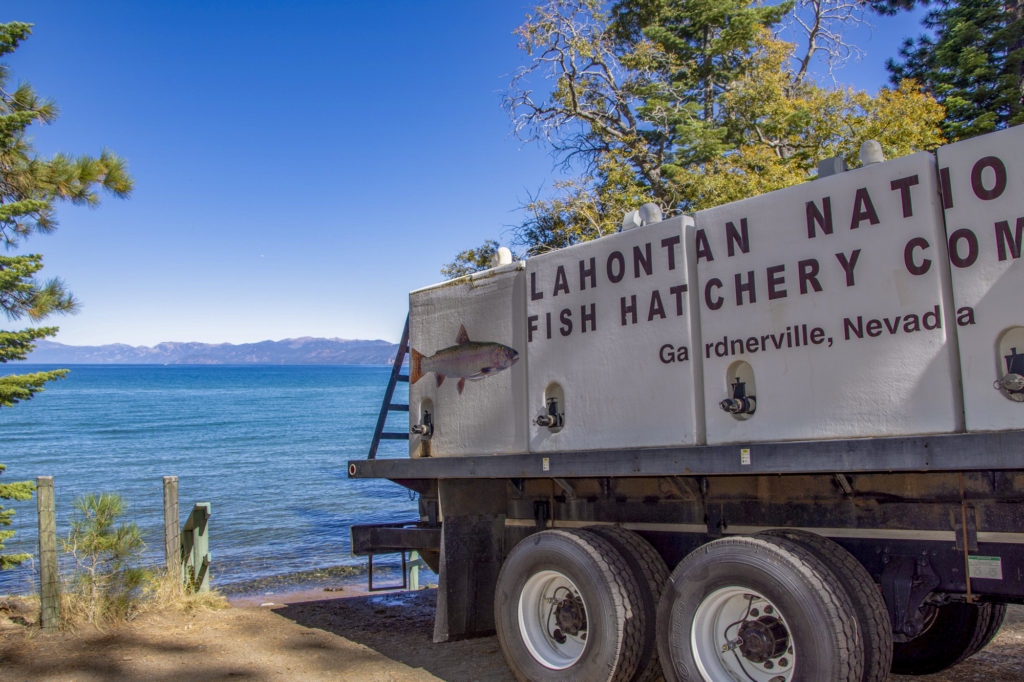
By Joanna Gilkeson
Lahontan cutthroat is the only trout species native to Lake Tahoe, yet they completely disappeared from that ecosystem by the 1930s. This was mainly due to sweeping shifts in natural resource management, like logging and overfishing from early settlement in the West in the 1900s.
As numbers of Lahontan cutthroat trout dwindled, their position as top predator in Lake Tahoe was backfilled by stocked non-native sportfish such as lake trout, rainbow trout and kokanee salmon.
The cutthroat continued to decline across its range and was eventually listed under the Endangered Species Act in 1970. Since listing, the U.S. Fish and Wildlife Service has been developing and implementing strategies to help the trout return home.
Beginning in 2002, USFWS’s Lahontan National Fish Hatchery Complex started working to restore the iconic lake-form of Lahontan cutthroat trout in Fallen Leaf Lake, located in the Tahoe Basin. Through years of reintroduction, research, adaptive management and partnerships, much has been learned about the conservation needs of Lahontan cutthroat trout in Lake Tahoe.
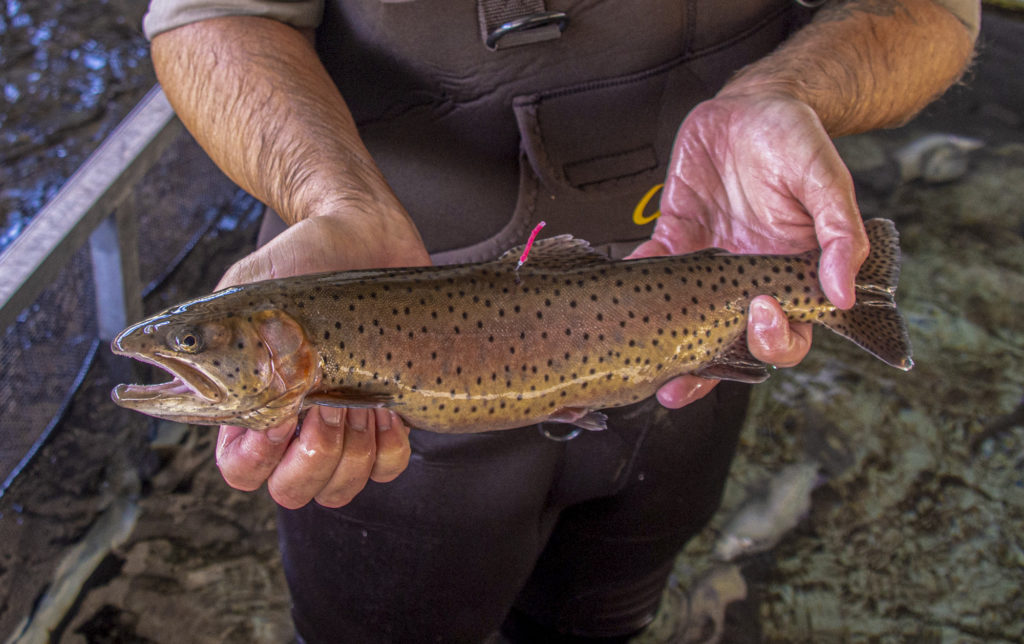
AFTER YEARS OF PLANNING and hard work, the Lahontan National Fish Hatchery, for the first time ever, released approximately 2,000 fish into Lake Tahoe on Oct. 5, 2019. The stocking event occurred in tandem with the U.S. Forest Service Lake Tahoe Basin Management Unit’s Fall Fish Festival near South Lake Tahoe.
“Lahontan National Fish Hatchery’s broodstock population represents the genetic legacy of the original Lahontan cutthroat trout population that once thrived in Lake Tahoe,” said Lisa Heki, project leader for the Lahontan National Fish Hatchery Complex. “With this stocking event, the trout is returning home.”
The colorful 12- to 14-inch fish were released from a large holding truck through a stocking tube. The trout could be seen darting through the clear, crisp alpine lake, and even ran into a few spectators’ legs as they swam to freedom.
Stocking will enhance angling opportunities in Lake Tahoe and improve visibility of this important native trout in local communities and for those recreating in the area.
The hatchery followed up with a second stocking on Oct. 6, at the same location near Kiva Beach along Lake Tahoe. Over the course of the Fall Fish Festival, several hundred people watched the hatchery reintroduce the native Lahontan cutthroat trout into Lake Tahoe.
For Heki, the event is a highlight of her career.
“It was exhilarating to see the native trout return to their home waters in beautiful Lake Tahoe after years of working for this moment,” she said. “Sharing it with the enthusiastic and supportive people of Lake Tahoe made it truly special and encouraging for the future of this unique trout.”
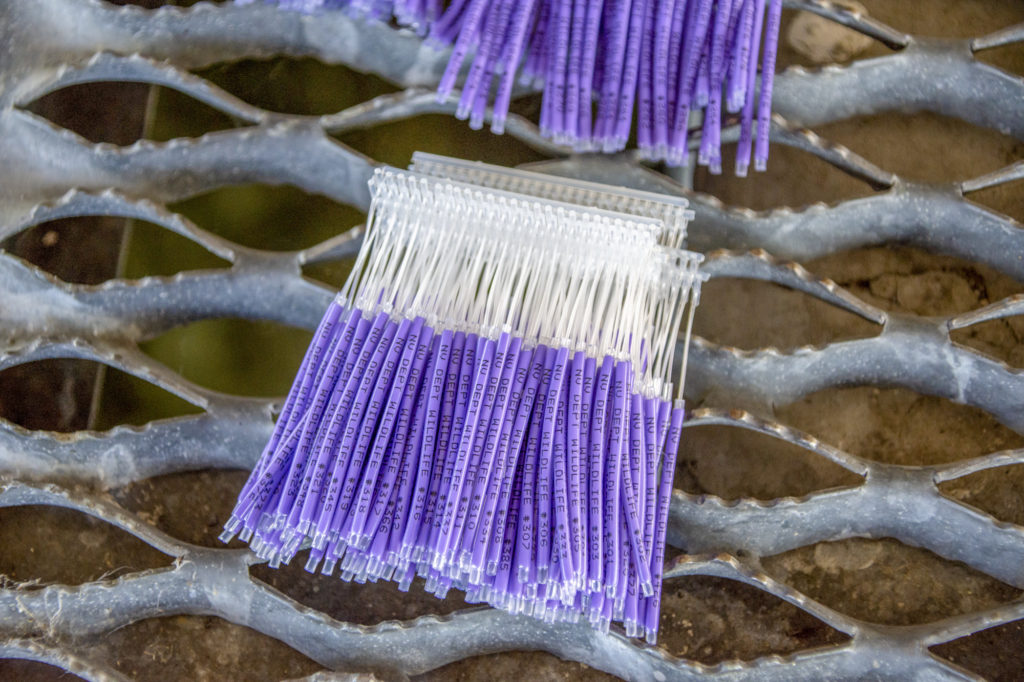
A THIRD AND FINAL stocking effort was held on Oct. 7 at Sand Harbor State Beach in Nevada in partnership with Nevada Department of Wildlife.
A total of 5,000 fish were released over the course of three days, all with the adipose fin clipped to help anglers identify stocked fish.
About 2,000 of these fish also received an external tag known as a “floy tag.” The tags encourage anglers to call a hotline and report the stocked fish along with as much information as possible about the catch.
“The data gathered from the floy-tagged fish will help us understand how Lahontan cutthroat trout are using habitat in the lake,” said NDOW fisheries biologist Travis Hawks. “This information will be crucial in the future recovery of the species in the Tahoe Basin.”
Reports from the public will assist NDOW and USFWS in collecting data and information about the movement and survival of these fish after release.
Other partners in this effort include the California Department of Fish and Wildlife and Tahoe Regional Planning Agency. CS
Editor’s note: Joanna Gilkeson is a public affairs specialist at the Reno office of the U.S. Fish and Wildlife Service. For more on the USFWS Pacific Southwest region, go to fws.gov/cno.
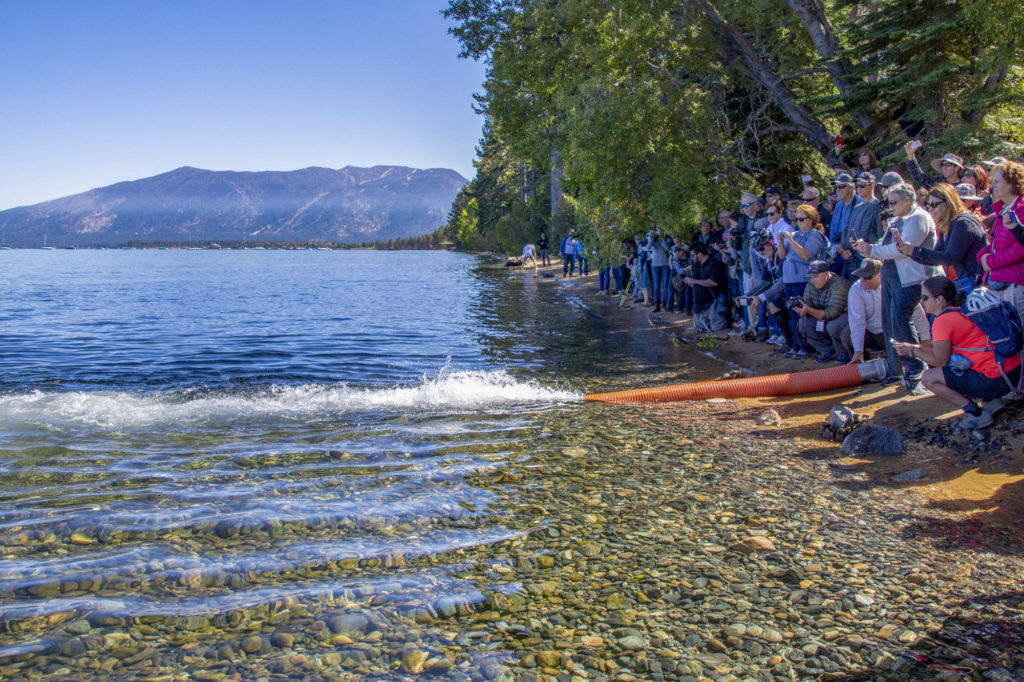
Sidebar: Q&A WITH BIOLOGIST LISA HEKI
In the early 1990s, Lisa Heki corresponded with a colleague, Utah biologist Bryce Nielson, who told her he found what appeared to be a strain of Lahontan cutthroat trout in a small stream in the Pilot Mountains along the Utah-Nevada border. Heki, a Nevadan whose career started as a biologist with the U.S. Forest Service, was intrigued with the possibilities.
“He was reaching out to me and seeing what could be done to bring this strain back to its native waters in Nevada. He saw the potential and that really started our path,” Heki says of Nielson’s urging that would fan the flames to get the fish back to Nevada’s Pyramid Lake, the Truckee River and, ultimately, on the other end of the Truckee in Lake Tahoe.
“What a series of unlikely events that brought this fish back to its native habitat.”
Editor Chris Cocoles caught up with Heki to get a little more perspective on this comeback story.
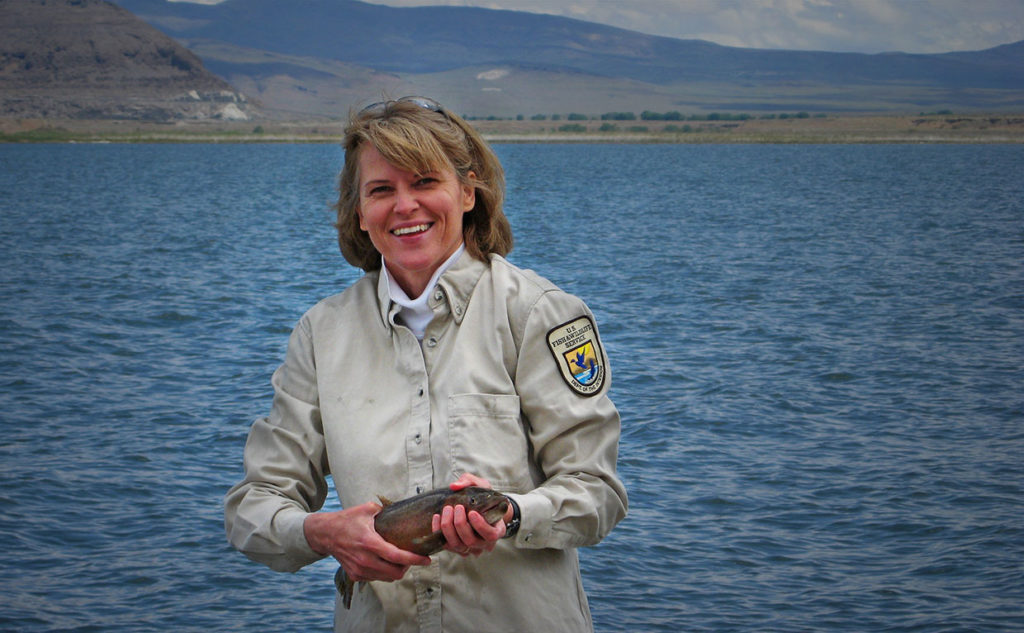
Chris Cocoles You’ve been essentially working on this project since the mid-1990s. What’s the evolution of this been like for you?
Lisa Heki The evolution of recognizing the value of Lahontan cutthroat trout in the Pyramid-Tahoe-Truckee corridor, to see it come to fruition with the building blocks … and really seeing this trout thrive, even in modified habitat, has been just such an amazing experience to see the resilience of native species and their ecosystems. And to see the partners who have been working with us along the way and in support of this unique trout. Between the stocking and the partnership with the Pyramid Lake Paiute tribe and now the Tahoe community that is embracing its native trout as well, I’m just beyond thrilled for this species.
CC Were there lots of lows and highs as you’ve worked on this?
LH The challenges have been for years talking about the potential of the genetic legacy that was captured in that very small population. It can be difficult. It’s a pretty significant paradigm shift in reestablishing what everyone thought was gone. And so you have to bring folks along with the science and motion of that paradigm shift. But that has also been a valuable part of my career – to learn and grow and understand how to communicate this opportunity to the people in these basins. It’s been an opportunity that I couldn’t have had otherwise but for my career with the U.S. Fish and Wildlife Service.
CC So was the day earlier this year when the trout were released in Lake Tahoe very emotional for you?
LH It was very significant for me personally. My son went to the public meetings I had at Fallen Leaf Lake in Tahoe when he was only 18 months old in 2001. And now he’s 19 so it’s been a family endeavor, shall we say?
CC Like a lot of native fish that decline, did the Lahontan cutthroat face a lot of adversity after they were once thriving in Pyramid Lake and Lake Tahoe?
LH They were a very important commercial fish – and so important that they were overfished and were sent to all kinds of restaurants across the country, in train cars to San Francisco and even back east. Tahoe had a slightly different history in that the mining and timber harvests really modified the habitat. The sawmills and the sawdust actually influenced the Truckee-Pyramid system and clogged the rivers. So that had an impact, along with the overfishing.

CC In both Tahoe and Pyramid, these fish were badasses, right?
LH Lahontan cutthroat trout were the top predator in both. They were long-lived in both systems. They reached a large size in both systems. And they are highly piscivorous – they are fish eaters primarily once they get about 12 inches in length. And they’re the largest inland trout in the world. There’s an anecdotal report of a 63-pounder in Pyramid that was caught. But 45 to 50 pounds was probably the top in size.
CC In a perfect world, had it not been for the variables that contributed to their demise, are these lakes perfect habitat for the Lahontans?
LH They seriously do quite well in their home waters and that’s the key for these native species. The big issue was modification to habitat, access to spawning tributaries and overfishing. So that really knocked them down. And probably (consumption by) rainbows was probably next. Their introduction came around the same time (Lahontans) started to disappear.
And you have mysis shrimp that were added in, I think, the 1950s to feed the lake trout. And that’s a huge issue for the health of the Tahoe ecosystem. It’s this huge biomass that migrates vertically and pushes out native zooplankton, which impacts native fish.
CC From a biologist’s perspective it had to be heartbreaking to know this sacred fish all but disappeared, but has that now become an inspiration given that the trout could be back?
LH If you read the stories about their complete disappearance from the Pyramid-Truckee corridor, it is a tough read and it’s something that looks implausible to recreate 30 years or 40 years later. Getting the support and understanding that with the discovery of this strain related to the original populations in Tahoe and Pyramid, for convincing partners and communities it does take time. These natives are resilient and they can find a foothold in their home waters with our help.
CC Are there still a lot of challenges these fish will face?
LK For the Pyramid-Truckee system – and keep in mind that there’s not a lot of data and we are on the ground floor of learning about them coming back – they wait to reach sexual maturity and now we have a naturally reproducing population coming up from Pyramid Lake and the Truckee River. There are going to be challenges for watershed connectivity. They really need to get upriver (on the Truckee) like they used to. They’re big fish and need colder water for spawning and incubation. But the Bureau of Reclamation is funding a screen at Derby Dam, which is about 45 miles upstream of Pyramid Lake so that we can together operate that fish passage structure.
With the stocking in Tahoe itself, we need to work on understanding all the tributaries. The only real challenges I see are managing those spawning migrations. I’m pretty encouraged that we’ll be able to address that down the road. The Lake Tahoe Restoration Act is legislation intended to continuing to fund the federal and nonfederal partnership in Lake Tahoe. There is $20 million there for Lahontan cutthroat trout. There’s a lot of support to make this happen.
CC You’re an angler too, so how special would it be for you having been a key part of reintroducing these native trout if someday you catch and release a big fat Lahontan cutthroat trout – maybe while out there with your family?
LK Just to be out there (fishing) with my family and perhaps someday my grandkids, I can say that I was a part of this. It’s very emotional for me to see nature come back and be successful. It’s a story my family will hear from me often.
We’ve had a couple of anglers call in and say they’ve caught these fish in Tahoe. One individual was on the other side of the lake from where they were stocked, so the angling community has embraced this potential. And they are so excited about their place in helping us understand how these fish will use their native ecosystems and having the opportunities to catch something that was forever gone. I think it’s just a great conservation recreational fishing story that brings all parties to the table. CS



